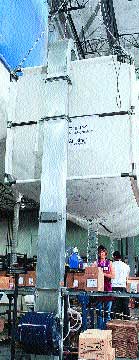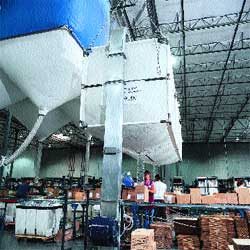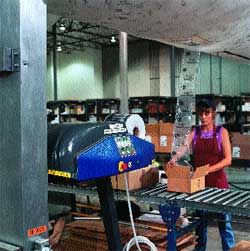January 29, 2014
|
|
Book-packing area in the Reno DC, top photo, includes a large Air Binz cushion storage unit suspended over two case-packing lines. An adjacent metal vent feeds the cushions from the cushion maker, center photo, to the bin. Perforated chain of cushions hangs from the bin and can be torn off as needed. Bin holds a day's worth of cushioning material. |
Publishers Group West claims to be the largest exclusive distributor of independent publishers in North America, and is among the top 10 vendors of books in the country. Headquartered in Berkeley, CA, PGW represents 125 independent publishers and has distribution centers located in Reno, NV, and Lebanon, PA. Since the company ships some 3,500 cases of books each day, product protection in-shipment is critical.
And, since retailers prefer to receive shipments that are easy to handle, PGW reviewed some of its shipping case cushioning materials and switched to a new void-fill cushioning method from Pactiv Corp. that's user-friendly, protective and economical with shipping expenses.
PGW, which distributes books internationally and manages a broad range of titles from educational, business, children's and travel, knows that inner packing components must be tidy too, according to the company's account of a recent shipping-case cushioning saga. A dilemma arose at the packaging facility in the company's 300,000-sq-ft DC in Reno, as some customers became displeased with the previous cushioning used in their book shipments. "We had been using an environmentally friendly void-fill in our shipping cases to help protect the books," explains operations manager Patty Olmstead. "However, some customers complained about the mess they had after the cases were opened. Some even pointed out disposal challenges."
It was then that the Reno plant began to research cushioning alternatives, she says. Its research led to the purchase in January of a Pactiv Air 3000™. The void-fill air-cushion dispensing system creates void fill on-demand, in-house, by converting tubular rolls of polyethylene film into continuous, perforated chains of air-filled cushions at 5.5 cu ft/min. Perforated in a continuous web, the inflated cushions resemble film pillows, and can be created in sizes up to a maximum width of 8 in., with lengths varying from 3 to 20 in. Primarily, PGW uses cushions in 8-in. lengths to fill shippers with 10 to 30 lb of books.
The cushioning material's perforations allow each pillow-style cushion to be quickly torn off from the chain and easily placed inside the shipping case. Lightweight and puncture-resistant, the pillow bags can nest snugly against PGW's books packed in shipping cases. "We can typically go through three to five rolls of cushioning material in a day," Olmstead says.
Chapter 2: overhead storage
Prior to converting, the Pactiv Air 3000 cushioning material is compressed, occupying about 1 percent of its converted volume. Cushions return to the compressed format when deflated, so there's no need for storage and handling of bulkier materials. PGW's machine is positioned near the infeed tube that carries cushions up and into a holding unit suspended from the ceiling over two packaging lines, to help save floorspace in the plant. The custom holding bin is now known as Pactiv's Air Binz™ overhead storage unit. In the packaging area, an operator can pull and tear off inflated cushions as needed from the chain feeding from the overhead bin and can place them in the corrugated shipper. Because the void-fill cushions are created on-demand by the portable, 60-lb tabletop machine at the push of a button, inventory and warehouse needs are minimized for preformed cushioning materials, Olmstead says.
 Also, she says, there's no mess upon opening a shipment, as the cushions can be reused if desired or recycled, and collapse flat when deflated. "The feedback we have gotten is positive," she tells PD. "Customers have told us they appreciate not having a mess of cushioning to clean up. We were also pleased about the additional bonus of reduced shipping costs. This is a benefit that we've been able to pass along to customers." Specific cost savings are difficult to pinpoint, she points out, however, because the costs vary, as no two shipments ever contain the same order or book titles or weigh the same. "But we know our customers are probably seeing lower shipping costs because the shipments overall weigh less."
Also, she says, there's no mess upon opening a shipment, as the cushions can be reused if desired or recycled, and collapse flat when deflated. "The feedback we have gotten is positive," she tells PD. "Customers have told us they appreciate not having a mess of cushioning to clean up. We were also pleased about the additional bonus of reduced shipping costs. This is a benefit that we've been able to pass along to customers." Specific cost savings are difficult to pinpoint, she points out, however, because the costs vary, as no two shipments ever contain the same order or book titles or weigh the same. "But we know our customers are probably seeing lower shipping costs because the shipments overall weigh less."
Olmstead goes on to say that PGW discovered that the lightweight cushions have a positive effect on disposal. In order to implement the new system, PGW worked with Pactiv to design a custom Air Binz overhead unit in which to store ready-made cushions so that a steady supply would be available to feed two separate packaging stations. The resulting Air Binz storage/dispensing unit features a heavy-gauge canvas construction with metal framing. The bottom features a zipper opening for easy access to the cushions.
To vent the unit and feed the just-made cushions into the canvas bin, a metal tube, assisted by a gentle stream of pumped air, quickly transfers cushions from the Air 3000 machine to the suspended bin. The vent unit is situated at the dispersing end of the Air 3000 and extends up 15 ft and curls into the Air Binz unit. PGW stocks up on cushions for each day's production needs by running the void-fill dispensing machine an extra three hours the evening prior.
In production, the books are computer-scanned for inventory control purposes, shrink-wrapped on an Arpac system and case-packed by hand as they travel down a conveyor belt to the two packing stations. To line the shipping cases with cushions, attendants at each station simply reach up to the "chain" of cushions trailing from the bottom of the Air Binz holding unit. The cases are then lined with the appropriate number of cushions and are taped closed with the help of Little David tape sealers from Loveshaw. With that, the Reno plant has happily closed a chapter on its void-fill tale, deeming it a successful ending to another project in the world of book distribution. "The new system has freed up some space formerly used to hold the previous cushioning," Olmstead says. "A lot of our customers say the new cushioning is easier to deal with and reduces the costs of shipping."
More information is available:
Void-fill dispensing, cushioning: Pactiv Corp., 877/692-6163. Write No. 209.
Shrink wrapping: Arpac, 708/678-9034. Write No. 210.
Case sealing: Loveshaw Corp., an ITW co., 800/572-3434. Write No. 211.
About the Author(s)
You May Also Like




